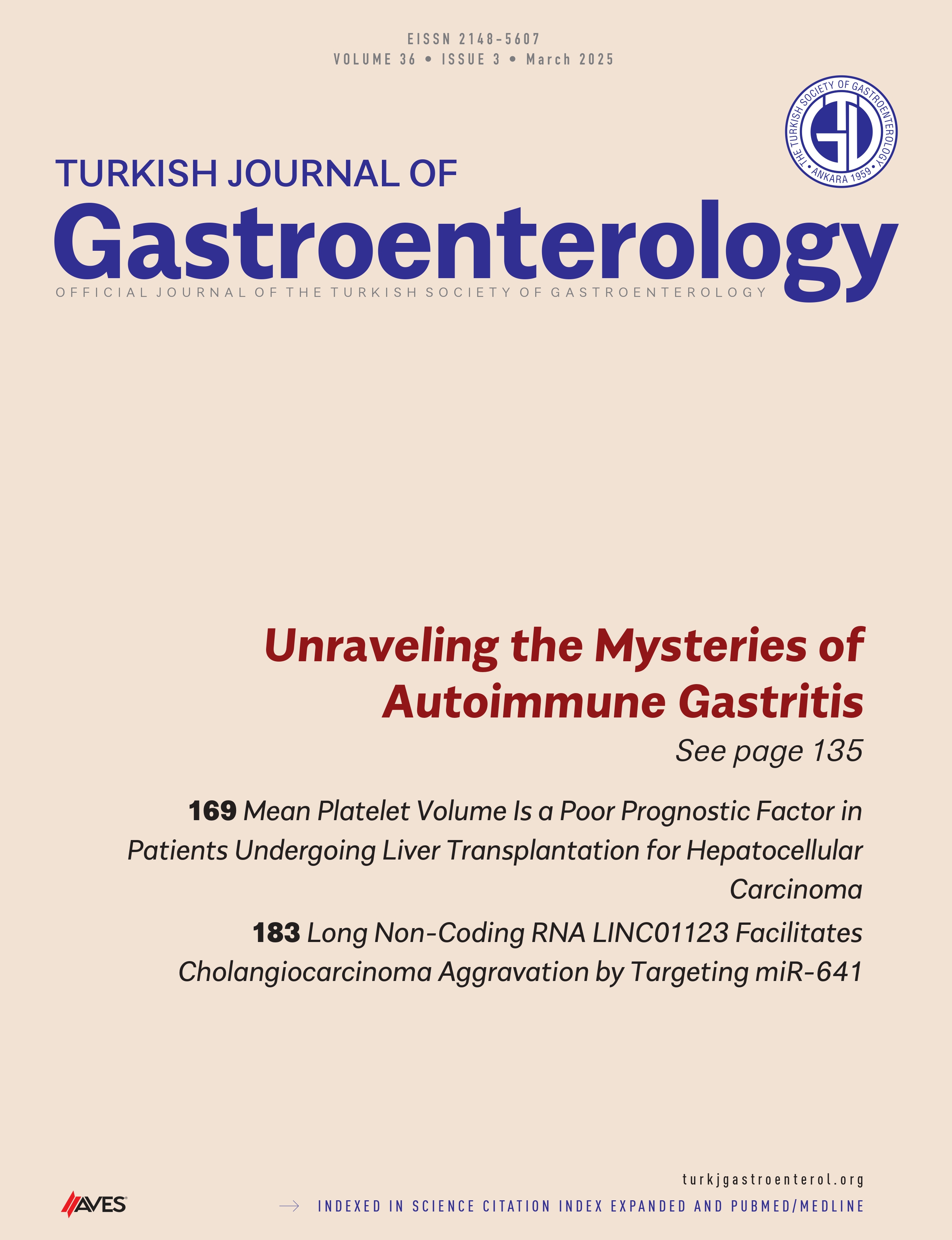Metabolic and Hepatic Profiles of Non-Obese and Obese Metabolic Dysfunction-Associated Steatotic Liver Disease in Adolescents: The Role of FibroScan Parameters,Fibroblast Growth Factor-21, and Cytokeratin-18
Main Article Content
Abstract
Background/Aims: Metabolic dysfunction-associated steatotic liver disease (MASLD) in adolescents, including non-obese phenotypes, is an increasingly important public health issue. The current study investigated the use of controlled attenuation parameter (CAP) and liver stiffness measurement (LSM) as non-invasive tools, along with fibroblast growth factor-21 (FGF-21) and cytokeratin-18 (CK-18), in non-obese MASLD, obese MASLD, and healthy control groups, exploring metabolic and hepatic profiles in these groups.
Materials and Methods: This cross-sectional study recruited 195 adolescents aged 9-18 years, stratified into controls (n = 92), non-obese MASLD (n = 32), and obese MASLD (n = 39) groups according to FibroScan and MASLD diagnostic criteria. FibroScan measured LSM and CAP, while enzyme-linked immunosorbent assay kit (ELISA) was used to analyze serum FGF-21 and CK-18 levels. Anthropometric, metabolic, and liver enzyme parameters were assessed.
Results: Metabolic dysfunction-associated steatotic liver disease groups had higher LSM than controls. Fibroblast growth factor-21 levels were significantly higher in MASLD groups, especially in obese MASLD, while CK-18 levels showed variability without significant group differences. Obese MASLD adolescents had marked metabolic dysfunction with higher insulin, homeostasis model assessment for insulin resistance, triglycerides, and liver enzymes compared to non-obese MASLD and controls.
Conclusion: Fibroblast growth factor-21 has emerged as a potential biomarker for assessing metabolic dysfunction in MASLD, while LSMs from FibroScan provide valuable insights into fibrosis risk. Elevated FGF-21 levels and FibroScan parameters reflect their potential usefulness in non-invasive assessment of MASLD severity, particularly in obese adolescents. However, further longitudinal studies are needed to establish their roles in predicting disease progression and guiding clinical management.
Cite this article as: Keskin M, Aysegul Arsoy H, Kara O, et al. Metabolic and hepatic profiles of non-obese and obese metabolic dysfunction-associated steatotic liver disease in adolescents: the role of FibroScan parameters, fibroblast growth factor-21, and cytokeratin-18. Turk J Gastroenterol. 2025;36(3):152-161.
Article Details
References
1. Vos MB, Abrams SH, Barlow SE, et al. NASPGHAN clinical practice guideline for the diagnosis and treatment of nonalcoholic fatty liver disease in children: Recommendations from the Expert Committee on NAFLD (ECON) and the North American Society of Pediatric Gastroenterology, Hepatology and Nutrition (NASPGHAN). J Pediatr Gastroenterol Nutr. 2017;64(2):319-334. [CrossRef]
2. Leung JCF, Loong TCW, Wei JL, et al. Histological severity and clinical outcomes of nonalcoholic fatty liver disease in nonobese patients. Hepatology. 2017;65(1):54-64. [CrossRef]
3. Nobili V, Alisi A, Raponi M. Pediatric non-alcoholic fatty liver disease: preventive and therapeutic value of lifestyle intervention. World J Gastroenterol. 2009;15(48):6017-6022. [CrossRef]
4. Dushay J, Chui PC, Gopalakrishnan GS, et al. Increased fibroblast growth factor 21 in obesity and nonalcoholic fatty liver disease. Gastroenterology. 2010;139(2):456-463. [CrossRef]
5. Feldstein AE, Wieckowska A, Lopez AR, Liu Y-C, Zein NN, McCullough AJ. Cytokeratin-18 fragment levels as noninvasive biomarkers for nonalcoholic steatohepatitis: A multicenter validation study. Hepatology. 2009;50(4):1072-1078. [CrossRef]
6. Desai NK, Harney S, Raza R, et al. Comparison of controlled attenuation parameter and liver biopsy to assess hepatic steatosis in pediatric patients. J Pediatr. 2016;173:160-164.e1. [CrossRef]
7. Yılmaz Y. The Heated Debate over NAFLD Renaming: an Ongoing Saga. Hepatology Forum; 2023. [CrossRef]
8. Jang SY, Kim HJ, Chang JY. Association of changes in body mass index and waist circumference with cardiovascular risk in non-alcoholic fatty liver disease: A nationwide study. Dig Liver Dis. 2023;55(11):1509-1514. [CrossRef]
9. Vittorio J, Lavine JE. Recent advances in understanding and managing pediatric nonalcoholic fatty liver disease. F1000Res. 2020;9:F1000 Faculty Rev-377. [CrossRef]
10. Chen X, Shi F, Xiao J, et al. Associations between abdominal obesity indices and nonalcoholic fatty liver disease: Chinese visceral adiposity index. Front Endocrinol. 2022;13:831960. [CrossRef]
11. Mathew M, Pope ZC, Schreiner PJ, et al. Non-alcoholic fatty liver modifies associations of body mass index and waist circumference with cardiometabolic risk: the CARDIA study. Obes Sci Pract. 2024;10(2):e751. [CrossRef]
12. Pacifico L, Nobili V, Anania C, Verdecchia P, Chiesa C. Pediatric nonalcoholic fatty liver disease, metabolic syndrome and cardiovascular risk. World J Gastroenterol. 2011;17(26):3082-3091. [CrossRef]
13. Yu SJ, Kim W, Kim D, et al. Visceral obesity predicts significant fibrosis in patients with nonalcoholic fatty liver disease. Medicine. 2015;94(48):e2159. [CrossRef]
14. Sasso M, Beaugrand M, de Ledinghen V, et al. Controlled attenuation parameter (CAP): A novel VCTE™ guided ultrasonic attenuation measurement for the evaluation of hepatic steatosis: preliminary study and validation in a cohort of patients with chronic liver disease from various causes. Ultrasound Med Biol. 2010;36(11):1825-1835. [CrossRef]
15. Karlas T, Petroff D, Sasso M, et al. Individual patient data meta-analysis of controlled attenuation parameter (CAP) technology for assessing steatosis. J Hepatol. 2017;66(5):1022-1030. [CrossRef]
16. Yilmaz Y, Eren F. Serum biomarkers of fibrosis and extracellular matrix remodeling in patients with nonalcoholic fatty liver disease: association with liver histology. Eur J Gastroenterol Hepatol. 2019;31(1):43-46. [CrossRef]
17. Li H, Fang Q, Gao F, et al. Fibroblast growth factor 21 levels are increased in nonalcoholic fatty liver disease patients and are correlated with hepatic triglyceride. J Hepatol. 2010;53(5):934-940. [CrossRef]
18. Czaja AJ. Review article: the prevention and reversal of hepatic fibrosis in autoimmune hepatitis. Aliment Pharmacol Ther. 2014;39(4):385-406. [CrossRef]
19. He L, Deng L, Zhang Q, et al. Diagnostic value of CK-18, FGF-21, and related biomarker panel in nonalcoholic fatty liver disease: A systematic review and meta-analysis. BioMed Res Int. 2017;2017:9729107. [CrossRef]


